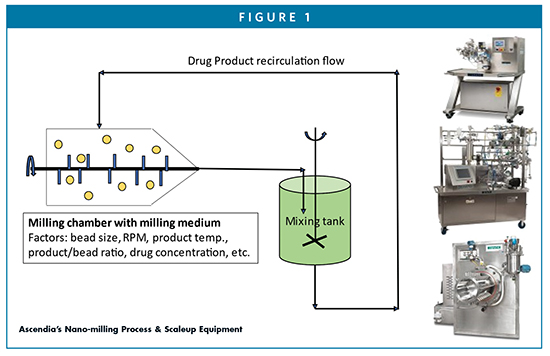Issue:June 2021
FORMULATION FORUM - Nanosuspension Dosage Forms: Product Development & Scale Up
INTRODUCTION
Nano-formulation of poorly water-soluble drugs has been proven in commercial products to 1) enhance drug dissolution and oral bioavailability, and 2) increase drug loading and release duration for parenteral drug delivery. Preparation of drug nanosuspensions can be top-down, bottom-up, or a combination of both techniques. This month’s forum will focus on nanosuspensions prepared via the top-down process, ie, wet milling process.
During the nanosuspension formulation development process, efforts should first focus on screening to identify the lead formulation that generates stable nanosuspensions that achieve the desired drug efficacy and pharmacokinetic properties in animals and humans. Thereafter, the nano-milling process should be optimized to determine the critical process parameters with the aid of factorial design during scale up. Finally, consideration should be made in how the nanosuspensions can be incorporated in the final market image dosage form per the desired pharmaceutical product profiles based on the need of patients and available technologies.

QUALITY TARGET PRODUCT PROFILE OF NANOSUSPENSIONS (QTPPS)
A Target Product Profile (TPP) is a planning tool for therapeutic candidates based on FDA guidelines. Based on the relationship between product quality attributes and product safety and efficacy profiles, a Quality Target Product Profile (QTPP) should be determined to define the desired profiles of the finished product and Critical Quality Attributes (CQAs). Below is an example of QTPPs and CQAs for a sterile nanosuspension dosage form.
FORMULATION DESIGN OF NANOSUSPENSIONS
Successful nanosuspension formulation development depends on careful evaluation of compound physical chemical and biopharmaceutical properties, such as solubility, pKa, solid surface properties, permeability, meting point, and crystal lattice structure. A good candidate for nanosuspension has the characteristics of BCS Class II compounds: low solubility, high melting point, high permeability, and a strong tendency of food effects. A formulation screening study is usually conducted under a small scale to find the suitable stabilizer(s), ie, a polymer, a surfactant, or a combination of polymer/surfactant for the nanosuspension. Different surface properties of API, such as surface charge, hydrophobicity, functional groups responsible for ionic, hydrogen bond, and Van der Waal interactions, may demand different types and levels of stabilizers. The performance of nanosuspensions should be confirmed by in vitro studies, such as stability, re-dispersibility, and in vivo performance in animal models.
Selection of stabilizer(s) is crucial for nanosuspension formation and stability, which should be the first step in the development of the nanosuspension product. The stabilizer can help prevent drug particles aggregation during milling and storage, and to stabilize the freshly created surfaces during the milling process. Factors such as stabilizer(s), milling speed and time, temperature, drug loading, bead size, and ratio of drug suspension to the milling medium, etc, play a significant role in the particle size distribution of the milled suspension. Stabilizers can stabilize drug suspension by a mixture of a polymer, ie, steric stabilizer (Poloxamer, PVP, HPC, PVPVA, PEG, etc), and an ionic/nonionic surfactant, ie, electrostatic stabilizer (Tween, SDS, sodium deoxycholate, Pluronic, etc).
QBD DESIGN IN PROCESS DEVELOPMENT
Figure 1 show a typical nano-milling process and scale up equipment utilized by Ascendia. The transfer of laboratory results for nano-milling from labs to production scale requires understanding of the critical process parameters, such as the specific energy input, stress energy of the grinding media, stress coefficient and residence time distribution. The product of stress number and stress energy is proportional to the specific energy input. When scaling up is performed, formulation variables and process parameters, which may have a significant impact on the nanosuspension production, are drug loading, stabilizer level, milling speed, time, temperature, grinding media size and density, suspending vehicle viscosity, ratio of the volume of formulation to grinding media, percentage fill of milling chamber, etc.

Preliminary formulation screening studies are often conducted in a lab milling system that has a different design from that of the scale up, which could result in different milling efficiency. Studies indicate the size of the grinding media, the peripheral speed of the agitator, and the density of the grinding media has a major impact on wet-milling in an agitator bead mill (literature information from NETZSCH-Feinmahltechnik GmbH). Kwade defined the stress energy of the grinding media as a function of grinding media density (ρGM), grinding media diameter dGM, and agitator peripheral speed (Vt). (A. Kwade Autogenzerkleinerung von Kalkstein in Rührwerkmühlen. Dissertation, TU Braunschweig, 1996, ISBN 3-8265-2082-3).

Kwade showed that with a constant specific energy input, there is an optimum stress energy in which the smallest product median particle size is achieved (Figure 2, adapted from Kwade’s paper).

SUMMARY
For drug nanosuspensions, parameters like stabilizer concentration, drug loading, milling speed, milling time, bead diameter/density, temperature, amount of beads versus drug product, etc, are important formulation and process variables. Critical process parameters (CPPs) that impact nanosuspensions’ critical quality attributes should be identified by means of a DOE design. The ranking of CPPs impact on CQAs may change as a result of a change in milling design during the scale-up process. It is important that a design space of the CPPs be defined during the scale-up process in order to achieve a robust formulation and manufacturing process.

Jim Huang, PhD
Founder & CEO
Ascendia Pharmaceuticals
j.huang@ascendiapharma.com
www.ascendiapharma.com
Total Page Views: 6644











